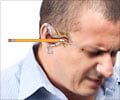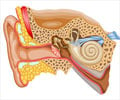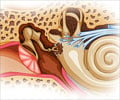A scoring system, termed 13-point symptom score, has been designed to help in monitoring improvement in infants and toddlers with middle ear infection, or acute otitis media (AOM), says a study reported in the January issue of The Pediatric Infectious Disease Journal.
The journal is published by Lippincott Williams & Wilkins, a part of Wolters Kluwer Health, a leading provider of information and business intelligence for students, professionals, and institutions in medicine, nursing, allied health, pharmacy and the pharmaceutical industry.Dr. Nader Shaikh and colleagues of Children's Hospital of Pittsburgh have authored two articles for the January issue of The Pediatric Infectious Disease Journal. The first article discusses the development of their new AOM symptom severity scale, the "AOM-SOS", and the second reports on the validation of the system in children with AOM.
In developing their new AOM-SOS, the researchers first created a list of 28 symptoms associated with middle ear infection, with input from pediatric experts and parents. They then narrowed the list to the seven most important AOM symptoms: ear pain, ear tugging, irritability, decreased play, decreased appetite, difficulty sleeping, and fever. These seven symptoms were incorporated into the 13-point AOM-SOS score. To calculate the AOM-SOS, the first six symptoms were rated on a 0-to-2 scale (none = 0, a little = 1, a lot = 2). The final symptom, fever, was rated either absent (0) or present (1).
AOM-SOS Shows When Ear Infections Are Getting Better
The researchers then evaluated how well the AOM-SOS reflected the presence and severity of AOM. The analysis was based on infants and toddlers who, as part of another study, underwent ear examination (otoscopy) at regular clinic visits during "respiratory season," from late fall to early spring.
At each visit, the children's AOM-SOS scores were calculated and compared with the results of otoscopy. The study included a total of 642 visits by 264 children, average age 12.5 months. The diagnosis of AOM was made in 24 percent of visits. When AOM was present, otoscopy showed swelling of the eardrum (tympanic membrane) in more than 90 percent of cases.
Advertisement
The AOM-SOS also reflected improvement in the severity of AOM. At visits where otoscopy showed improvement in AOM, the score decreased by an average of 2.8 points.
Advertisement
The researchers emphasize that the AOM-SOS is not intended for use in determining whether AOM is present—the diagnosis can only be made by a health care professional after physical examination. "Although symptoms alone are not sufficiently accurate to definitively diagnose AOM, we have shown that symptoms can be used to follow the course of the disease," Dr. Shaikh and colleagues write.
The AOM-SOS can be useful for research purposes, especially studies of the response to antibiotic treatment. It may also aid in comparing the results of different research trials. "Used to assess symptom burden on a daily basis, the AOM-SOS promises to be useful as an outcome measure in clinical studies of AOM," the researchers conclude.
Source-Newswise
PRI/SK















